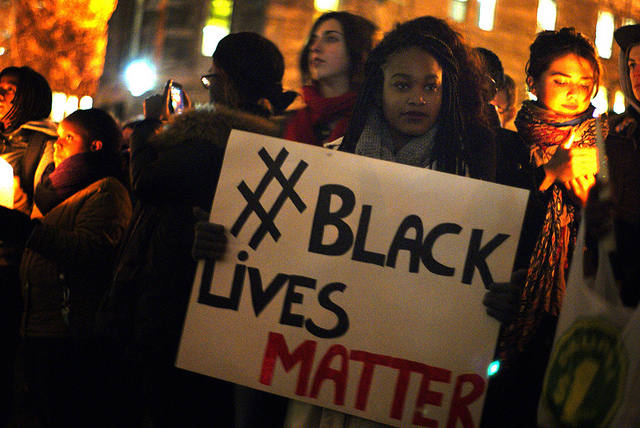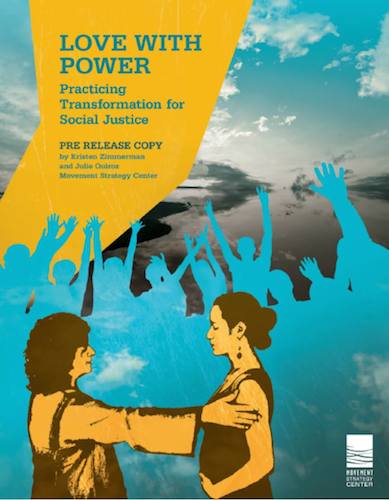With Great Love, MSC Offers This Excerpt From Love With Power: Practicing Transformation for Social Justice by Julie Quiroz and Kristen Zimmerman

Originally published on February 12, 2015.
In early October 2014, Alicia Garza arrived in Ferguson, Missouri. Less than two months after Ferguson Police officer Darren Wilson shot and killed unarmed 18-year-old Michael Brown, the community of Ferguson was under siege. In the wake of Brown’s death, grief and rage enveloped the city like dense smoke. Centuries of pain from racism, alive and embedded in schools, jobs, neighborhoods, and endless police harassment, rose to the surface. Police and White city officials responded to community protests with brutal force, trampling on the most basic aspects of human dignity and rights.
National and international media descended on Ferguson, turning the spotlight on every corner of residents’ lives. As national organizations arrived — often removed from local relationships and experience — residents reeled. The chaos of the moment and the trauma of witnessing and experiencing police assaults and murders left them not only angry, but disoriented and deeply mistrustful.
With the backing of the National Domestic Workers Alliance, Garza traveled to Ferguson to support local organizing, collect the stories of women on the front lines, and participate in the #BlackLivesMatter Freedom Ride. Garza hoped to engage Black communities in “building a movement to transform our nation.”

One year earlier, Garza and two other women, Patrisse Cullors and Opal Tometi, had conceived “Black Lives Matter” as a vision and response to Trayvon Martin’s murder by George Zimmerman in Florida. At the heart of Black Lives Matter was a message about humanity and human rights, shining a light on one question: what are all the things that stand in the way of humanity and valuing Black lives, all Black lives, in this country? Black Lives Matter was clear: police violence is a crucial focus, and just the tip of the iceberg. In a communication from Ferguson, Garza wrote:
Every 28 hours, a Black woman in this country loses her child to police or vigilante violence. When a child is killed by police or vigilantes, we all fall short in upholding the values that connect us all — care, love, respect and dignity. In a democracy that protects all of us, no child should have less of a chance at a future because of the color of their skin.
Garza, Cullors, and Tometi had deepened their personal and political relationships with each other for over a decade. During that time, they cultivated transformative practices, including building a practice community together through Black Organizing for Leadership and Dignity, and applied these practices to organizing. They honed their vision for a changed world. When the outrage at Michael Brown’s death erupted, they were able to move into the moment — ready or not — with new ideas and the sense that they wanted to support family in the biggest sense of the word.
Garza spent her first few days in Ferguson listening and getting to know people. She wondered how local organizing could be strengthened in this excruciating time, particularly given the deep suspicion of outsiders, like her. Bringing the skills and politics she had developed in her 15 years of organizing, Garza knew that focusing on building authentic relationships and shifting people’s way of being together could transform everything else.
My personal practice helped to ground me and reciprocate compassion, love, and understanding even when I was faced with “who the hell are you?”
Seeking to bring out the best in themselves and others, the Black Lives Matter team began to explore questions that people could connect to from the heart, asking, “why does this movement matter to you? What does “Black Lives Matter” mean to you? What is your biggest hope for this movement?”
My work in Ferguson training organizers was about cultivating a practice of taking care of each other. When someone got a job they had been waiting for we celebrated. When someone else couldn’t be with us because her mother was dying we made sure to call her and share the love and let her know her spirit was still there with us. When someone was fired from his fast food job for talking about organizing, we all came together, giving him love and telling him how brave and courageous he was. He came in upset but left feeling held.
These practices helped Garza build authentic relationships with the local organizing team relatively quickly. They were then able to return to the community and engage community members with that same spirit.
We went door to door simply trying to connect with people, finding what they need and where we share purpose and vision.
While they only spent two weeks together, Garza and the community of organizers she worked with found a rhythm, established practices that grounded their work in purpose, and built deep and authentic relationships with each other.
At the end of each day together we would come back and share food and experiences. Then we’d end with a chant or a song or a prayer. These rituals are really important. They ground us in our bodies and remind us how we got to this place. They remind us that all our ancestors did some kind of ritual. We were only together for two weeks in Ferguson but the people I connected with are still family.
Alicia Garza’s story from Ferguson is complex and still unfolding. It is a story of Black communities rising up to say no to the daily inhumanity of structural racism. It is the story of Black communities seeking to build from purpose and love. It is a story of movement builders nurturing transformative practices within social justice, then, stepping up and into a movement moment.
Collective transformative practice is not some hippy dippy thing. It’s about how we are together and how we are successful as movements. This is how #BlackLivesMatter thinks about transformative practice: It’s about transformative relationship building. It’s about practice as ritual.
The future depends on building these moments of high quality presence, clarity, insight, and heart-felt love. “Together,” says Garza, “we are organizing to build a new democracy and a society that values and protects all of our work and all of our families, and embraces who we truly are as a nation.”
Alicia Garza’s story from Ferguson leaves us with many important questions: How can we develop the collective strength and insight needed to transform a culture and an economy built on racism and domination? How can we cultivate our readiness to engage with extraordinary challenges — even when we don’t feel ready? What aspects of our social movements will continue to serve us, and what do we need to leave behind? How can we respond to a world of injustice and violence with the love and power we are just beginning to imagine?
How can we embody the world we want and need — right now?
Alicia Garza is a cofounder of #BlackLivesMatter and a director for the National Domestic Workers Alliance.
Check out another publication on transformative movement building: Transforming Lives, Transforming Movement Building: Lessons from the National Domestic Workers Alliance Strategy from the USC Program for Environmental and Regional Equity.
Julie Quiroz (she/her) leads New Moon Collaborations, nurturing leaps in culture that transform systems and structures for generations to come.
Kristen Zimmerman is co-founder of Movement Strategy Center and Root. Rise. Pollinate!


